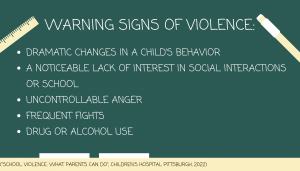14 School Violence
Lily Rogers
Introduction
School violence upsets learning and harms the students, schools, and the entire community (Centers for Disease Control and Prevention, 2016). School violence is not a specific type of violence. It rather refers to the location where the violence takes place. The aggression can occur on school property, on the way to or from school, during a school event, or traveling to or from a school event (Centers for Disease Control and Prevention, 2021). Violence rates are similar in urban, rural, and suburban areas; however, the top 10 states with the most threats and episodes are California, Florida, New York, Michigan, Pennsylvania, Ohio, Texas, Illinois, North Carolina, and Virginia (Pitofsky, 2018).

School Violence Statistics
In 2019, the Center for Disease Control (CDC) conducted a survey called the Youth Risk Behavior Survey (YRBS) (CDC, 2021). This survey was given to 13,677 high school students across the United States (CDC, 2021). Results for school violence from the YRBS showed that, in the last year, on school property:

- About 1 in 5 students were bullied
- 8% of students had been in one or more physical fights
- More than 7% of students had been threatened or injured one or more times with a weapon (i.e. a gun, knife, or club)
Causes of School Violence
There is no one cause of school violence. Every student thinks, feels, and acts differently. This can make it difficult to pinpoint the stressor that leads to violence. However, a common stressor tends to be poor mental health (Lyness, 2021). This stressor can also be combined with other issues to make the matter worse (Lyness, 2021). For more information on how mental health affects children, refer to these chapters: Toxic Stress and Resilience and Childhood Anxiety and Depression.
While reasons vary for violent behavior, some patterns do exist. Sometimes students act out in response to negative events that are directed toward them. This is called reactive aggression and is defined as “aggressive behavior evoked by threat, provocation, or frustration” (Lickley & Sebastian, 2018). For example, a student whose peers are bullying may resort to violence to release their anger (Lyness, 2021). A student’s class rank can be an indicator of violent tendencies. According to Comi et al. (2020), the higher up a student is in their class rank, the less likely they are to engage in violent behavior. In conjunction, students may also act out due to violence in their home life (Lyness, 2021). In this case, the student “copies” what they see at home because they see it as acceptable behavior. No research currently links adverse childhood experiences (ACEs) to school violence; however, it is known that ACEs contribute to psychotic experiences and disorders that can lead to violence (Ferrara et al., 2019).
Warning Signs and How to React
There are some major warning signs parents and guardians should be aware of that indicate a child’s tendency to be violent with others.

It is crucial for parents and guardians to know their child’s normal behavior and react appropriately. A few ways to prevent violence from escalating are to talk to the child and acknowledge their feelings, seek therapy, talk to their teachers and school staff, and most importantly, if a member of the household owns a gun, ensure all guns are unloaded, locked, and kept away from children (Children’s Hospital of Pittsburgh, 2022).
Health Effects
When people think of school violence, mass shootings are what first come to mind. While death resulting from school violence is the main issue, there are other aspects to think about. Looking first at physical harm, minor injuries can include bruises, cuts or scrapes, and broken bones. Most of these minor injuries can be healed and do not lead to major health issues. On the other hand, more serious injuries such as gunshot wounds and head trauma have the chance of causing more permanent damage (CDC, 2016).
However, these visible injuries are not the only results of school violence. Students who are exposed to violence of any kind, but especially when it happens to themselves or their peers, are more at risk for lifelong mental health issues (Ferrara et al., 2019). These mental health issues include anxiety, depression, post-traumatic stress disorder (PTSD), and other psychological problems.
Finally, school violence increases the chance of substance (alcohol and drug) use, as well as suicide (CDC, 2016).

Resources
Violent students, especially school shooters, do not fit a profile (Ferguson et al., 2011). Parents, school faculty and staff, and even students can prevent school violence. Strategies include creating anonymous reporting systems, training how to be aware of indicative behavior, monitoring common areas, utilizing the presence of a police officer or security guard on campus, and holding regular drills (i.e., fire, intruder, etc.) (National Association of School Psychologists, 2022). National programs are available to help people understand and learn how to prevent school violence (CDC, 2016). Below are some resources and programs for caregivers:
- STRYVE: Striving To Reduce Youth Violence Everywhere
- A nationwide initiative created by the CDC aims to prevent youth violence by increasing public health leadership and promoting violence prevention strategies.
- radKIDS
- radKids is a personal empowerment safety organization that teaches children how to be safe in many situations such as a fire, a stray dog, “stranger danger”, etc.
- Rachel’s Challenge
- Rachel’s Challenge offers assemblies and activities utilizing a proactive, preventative approach to bullying, school violence, and self-harm.
- YVPCs: National Centers of Excellence in Youth Violence Prevention
- The CDC’s academic-community collaborations work to advance youth violence prevention.
- Understanding School Violence
- A fact sheet put together by the CDC with extra information on understanding school violence.
Key Takeaways
- School violence upsets learning and harms the students, schools, and community. It occurs on school property, on the way to or from school, during a school event, or traveling to or from a school event.
- There is no one cause for school violence as every student thinks, feels, and acts differently; however, some triggers are poor mental health, bullying, class rank, and aggressive home life.
- Warning signs that a child may resort to violence include dramatic changes in a child’s behavior, a noticeable lack of interest in social interactions or school, uncontrollable anger, frequent fights, and drug or alcohol use.
- School violence injuries include minor and major physical damage and mental health issues.
- Parents, school faculty and staff, and students can prevent school violence by being aware of signs and being proactive.
References
Centers for Disease Control and Prevention. (2021, September 2). Preventing school violence. https://www.cdc.gov/violenceprevention/youthviolence/schoolviolence/fastfact.html
Centers for Disease Control and Prevention. (2016). School violence fact sheet-understanding school violence. https://www.cdc.gov/violenceprevention/pdf/school_violence_fact_sheet-a.pdf
Children’s Hospital of Pittsburgh. (2022). School violence: what can parents do. https://www.chp.edu/injury-prevention/teachers-and-parents/school-violence/parents
Comi. S., Origo, F., Pagani, L. & Tondello, M. (2021). Last and furious: relative position and school violence. Journal of Economic Behavior & Organization, 188, 736-56, https://doi.org/10.1016/j.jebo.2021.05.026.
Ferguson, C. J., Coulson, M., & Barnett, J. (2011). Psychological profiles of school shooters: Positive directions and one big wrong turn. Journal of Police Crisis Negotiations, 11(2), 141–158. https://doi.org/10.1080/15332586.2011.581523
Ferrara, P., Franceschini, G., Villani, A. and Corsello, G. (2019). Physical, psychological, and social impact of school violence on children. Italian Journal of Pediatrics, 45(1). https://doi.org/10.1186/s13052-019-0669-z
Ferrara, P., Franceschini, G., Namazova-Baranova, L., Vural, M., Mestrovic, J., Nigri, L., Giardino, I., Lucian Pop, T., Sacco, M., Pettoello-Mantovani, M. (2019). Lifelong negative influence of school violence on children. The Journal of Pediatrics, 215, 287–288., https://doi.org/10.1016/j.jpeds.2019.09.075.
Lyness, D. A. (Ed.). (2021, September). School violence: What students can do (for teens). KidsHealth. https://kidshealth.org/en/teens/school-violence.html
National Association of School Psychologists (NASP). (2022). School Violence Prevention. https://www.nasponline.org/resources-and-publications/resources-and-podcasts/school-safety-and-crisis/school-violence-resources/school-violence-prevention>.
Pitofsky, M. (2018, August 20). 51% of school violence incidents flared in just 10 states last year. Is your state one of them? USA Today. https://www.usatoday.com/story/news/2018/08/20/10-states-51-percent-school-violence-threats-2018/1031329002/
Lickley, R. A. & Sebastian, C.L. (2018). The neural basis of reactive aggression and its development in adolescence, Psychology, Crime & Law, 24(3), 313-333, DOI: 10.1080/1068316X.2017.1420187
Victor, D. and Taylor, D., (2022). A list of recent mass shootings in the united states (Published 2021). New York Times. https://www.nytimes.com/article/mass-shootings-2021.html
something that incites, instigates, angers, or irritates
Adverse Childhood Experiences are traumatic events that occur before the age of eighteen. ACEs include all types of neglect and abuse, such as parental abuse, incarceration, and domestic violence. ACEs also include trauma from a parent who may have fallen ill.
mental or emotional feelings or effects, as opposed to the physical aspect
showing, signifying, or pointing out; expressive or suggestive

